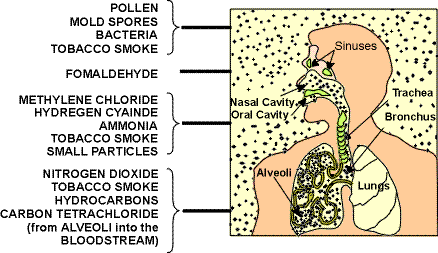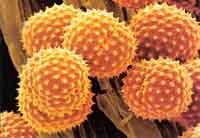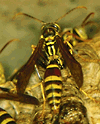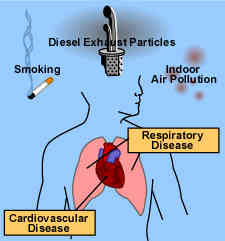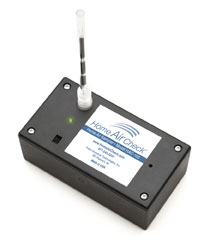|
Causes of Indoor Allergy Symptoms: Take A Holistic Approach to Avoidance
When trying to eliminate allergies a Holistic approach to avoidance is required because often times no ONE indoor air pollutant is solely responcible. The below response to a question submitted by a visitor to the Home-Air-Purifier-Expert.com suggests various factors that may contribute to indoor allergies. Overall, our general health and the state of our immune systems directly impacts how common allergens are transcribed into allergy symptoms such as: hives, sinusitis, allergic rhinitis, nasal allergies, cramps, vomiting, sneezing, dry cough, eye irritation, and difficulty breathing.
 I am also using an enzyme pet urine and odor remover quite often. Does one have anything to do with the other? I also develop nasal inflamations frequently that are very painful. We also have four cats. I keep the house very vacuumed...well, maybe not very. My main concern is the urine remover product. It is called Drs Foster & Smith Odor Logic/CleanAway. Ingredients are: Water, Microbile Enzyme Concentrate, Nonoxynol-10, Fragrance, Polysorbate 80. Thank you for a very informative site. Nancy, Atlanta, GA 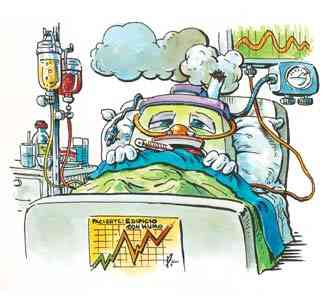 Thank you for taking the time to contact me Nancy. Thank you for taking the time to contact me Nancy. It sounds like you may be suffering from the symptoms of Chronic Allergic Rhinitis (a.k.a. Sinusitis) which could be related to indoor allergens like mold, pet dander, dust mites, or Volatile Organic Compounds off-gasing from something in your home. If your symptoms seem to disappear when you are not home, and if that pattern also holds true for others that enter and leave the same home, you may want to consider the possibility of having Sick Building Syndrome which can result from a number of indoor environmental factors like poor ventillation, VOCs from building materials, mold spores, ect. I also noticed you are in Atlanta which is known for its urban sprawl problem. There's thousands of automobiles on those interstates every day too. Therefore, your area is known for periodically serious levels of air pollution. Smog and ground-level ozone are a major public health issue especially during those hot and stagnant dog days of summer.
By the way, I just want you to know I can relate to you're symptoms. I havn't been able to taste anything or smell anything for over a week now, probably mostly due to severe Sinusitis as a result of the recent highest ever recorded pollen counts here. I'm not far down the road from Atlanta. I live here in beautiful upstate SC, not far from Clemson University.
Thank gosh it finally rained and washed some of it away. I'm just now getting my senses back! I also have two cantankerous black cats (black cats are the worst for allergies by the way). The cat dander they perpetually slough off can be some of the smallest and worst allergens known. Worse yet, my little black dander factories have electrostaticly charged fur so when I let them inside at the end of the day, they resemble big fat bumble bees due to all the yellow pollen attracted to their charged black fur! I have to take a wet rag and wipe the pollen off of them every evening - which is a seasonal ritual I think they are getting surprisingly fond of. That's probably why they now seem to roll around on the pollen covered ground with renewed vigour before coming inside. Such calculating little animals! Aren't cats amazingly uncanny at getting us humans to do exactly what they want?! Incidentally, I couldn't help but recall a funny piece I read from the "Best of Craigeslist" in which some guy is ranting about his "pathetically picky cats" (no, I promise I didn't write it, but I sure can relate to it. Cat owners in particular will get some good chuckles from it. Ok, so much for comic relief - Back to the serious topic at hand! Another little-known drawback of cats is that they can spread a parasite known as Toxoplasma gondii in their feces. The cat-born parasite can cause the disease in humans known as Toxoplasmosis - though it's harmless for most people. However, Congenital Toxoplasmosis may be particularly dangerous for pregnant women due to the possible complications it can cause such as fetal malformations and increased risk of abortion. Here's more information about Toxoplasmosis and pregnancy. When I got the first cat as a "gift" a few years ago I almost had to give her away because of the serious cat allergy I developed. My nose ran like a faucet, I had marathon sneezing fits, I got serious allergy hives with any little scratch or bite, and I think I even had "cat scratch fever" a couple of times (yes it's a real sickness).
I also think I had allergy problems from the odors and dust from their activities inside and outside their cat litter pan. The clay used in cat litter produces a lot of fine dust and dust of any sort can irritate the respiratory system and result in allergy symptoms. Even though I clean the cat litter box daily and change the litter frequently, I've also had problems with cat litter box odors. I've noticed a strong smell of ammonia coming from the pan after they urninate in the litter box. Cat urine can be very high in ammonia, especially if they are sick. Ammonia can be a serious inhalation hazard. To reduce the gaseous Ammonia (NH3) and "other odor" problem I started mixing a few cups of baking soda in with the cat litter - works very well to reduce odors of any kind. The baking soda also acts as a clumping agent for easy cleaning of the litter box. Baking soda (Sodium Bicarbonate) is also an excellant neutralizer so it reacts with the ammonium in the cat urine to lower the pH. This is why baking soda is great for neutralizing odors and also why it likely has anti-microbial properties as well. I love baking soda - it's a must have for any homeowner. It's non-toxic, inert, cheap, and can be used as a primary ingredient for safe and easy home-made recipes to replace hundreds of household chemicals and products. I buy it in bulk bags from Sams Club. Now back to those persnickety, frisky felines... Like the above disgruntled cat owner, I've also had problems with cat litter ending up where it shouldn't be. My cats - being the manipulative and sometimes neurotic little critters they are (don't get me wrong, I love those waskally little fur balls) - also seem to take great pleasure in seeing just how far and wide they can kick litter out of their litter box. I've noticed their little paws then track it throughout the house too - where it is an acute annoyance when walked on without shoes, and an inhallation hazard when it gets pulverized when walked on with shoes. It's amazing how that stuff seems to find its way into every nook and cranny of my house and the dust seems to collect everywhere. Cats definately increase the need for more frequent house cleaning. The clay probably has inorganic minerals in it which can cause respiratory sensitization (I plan to create a page specifically about chemical cat liter hazards sooon). If you think about it, the dust from the cat litter box can also act as airborne carriers of cat urine/feces particles. This fine dust can be inhaled deeply into your lungs and bronchiol tubes. Pleasant thought, huh? Unless you have a good quality HEPA vacuum, the smallest particles of cat litter and "other debri" you suck up into the vacuum cleaner will simply pass through the filter and be efficiently spewed into your indoor air. It's those smallest, non-visible particles that cause the worst allergy symptoms like burning watery eyes, sneezing, runny nose, and respiratory inflamations. Those are the exact symptoms I suffer every time I clean the room in which the cats spend the most time (and make the biggest messes).
At any rate, based on my own experience I would think your four-legged allergy factories are the primary culprit of your symptoms. You may be developing a hyper sensitivity - similar to how a single bee sting one year can have little affect for someone, but years down the road may mean full-blown anaphylactic shock the next time that same person is stung by a bee.
As another aside, for the majority of my life I have always been one of those very rare people who is immune to the affects of poison ivy. I mean I could roll around in it and never have any reaction what-so-ever - no kidding! However, things have changed there too. Last summer I observed one of my cats crouched in a patch of poison ivy and after picking her up, I had a reaction to the poison ivy oil she had collected on her fur (yes the cat strikes again!) I guess like most everyone else I'll now have to walk softly and carry a big bottle of camomile lotion.
As you may already have noticed, I have a philosophy of elliminating all man-made chemicals from my home whenever practical - and I sure don't listen to what the governement and corporations tell me about their safety. Unfortunately bottom lines often take presedence over our longterm health. That's why there's been very little safety testing on new chemicals and what has been done is often sorely inadequate. There's some serious conflicts of interest when you start looking into the relationships between government and "corporate citizens". Sorry, I get a little hot under the collar about that topic - back to your question at hand... All the ingredients you listed, with exception of water, can be chemical sensitizers - meaning you could develop allergic reactions to them. The Nonoxynol-10, Fragrance (which can mean hundreds of different chemicals), and Polysorbate 80 are probably the worst for that. I personally would never buy or use the sprays you're using. I buy very very little of any harsh chemicals or specifically marketed chemical products for pets, home, auto, bath, kitchen, ect. I still buy Tide detergent (use very sparingly), dish soap (dilute 50% - lasts a long time and rinses better too), and bar soap. Incidentally, as an indicator of how allergenic some of these "harmless" household products can be, consider this. For most of my life I have been using a Speed Stick deodorant brand-Mennen by Colgate-Palmolive Co. (phone: 1-800-228-7408); however, I recently developed a severe skin rash which I suspect is from the Speed Stick Deodorant. Even after a year I can't get it to heal and actually it now has me so worried that I think I will have to see a doctor soon about it (it takes a lot to get me to see a doctor). When I developed a rash I looked at the ingredients and warning on the Speed Stick deodarant for the first time. I was surprised to see what was in it and also the warning that was on it. I am quite sure I have developed a hyper sensitivity too and have ceased using it. It has several potentially serious skin sensitizers in it. The ingedients are Aluminum Zirconium Tetrachlorohydrex, Glycine Complex, Cyclomethicone, Stearyl Alcohol, C12-15 Alkyl Benzoate, Hydrogenated Castor Oil, PEG-8 Distearate, and Fragrance. The warning on the back says to stop using immediately if a rash develops (this indicates a possible history of complaints to the company for that). I've also noticed a warning that said not to use the product if you have kidney disease! This indicates that the product is not only absorbed into the blood stream through the skin (like most polar chemicals applied to the skin), but it also has components which are toxic to the kidneys. So some products may cause more than just allergy symptoms. The liver and kidneys are important for cleaning our blood of toxins. Interestingly, the kidney warning does not show up on the newer versions of the Speed Stick deodorant. They either removed the specific ingredient suspected as a possible kidney toxin or they might have removed it for "other" reasons. Either way, there's something else in it my body is now strongly allergic to, so I can't use it anymore. Many Europeans use a natural mineral salt-based deodorant which I intend to give a try.
Fortunately, there seems to be a renewed interest in "green products" like Simple Green Cleaner, all-natural pine cat litter, ect; however, in many cases you can still make your own home-made cleaners, ect which can be used for many different applications in the home. I mentioned Baking Soda, but another all-purpose non-toxic ingredient that is very effective is Vinegar. You can clean windows, bathrooms, kitchens, ect, ect with it. Try mixing equal parts of Vinegar and water to make your own pet odor neutralizer/cleaner. It's also an excellant drain cleaner when combined with Baking Soda (remember bubbling Volcanoes from school?) - combine the two in the sluggish or clogged sink drain (preferably after the water eventually drains out), wait about ten minutes. The vigorous production of Carbon Dioxide bubbles evolved when the two react does wonders to loosen stubborn sink-clogging deposits. After ten minutes, flush the drain with a pot of boiling water. Never buy the commercial drain cleaners because they are very toxic and can result in serious chemical burns. They contain Sodium Hydroxide which is one of the strongest caustic acids known. For more information about the toxic trade secrets found throughout your home have a look at my Household Chemical-pedia which explains what potentially toxic ingredients and hazards are found in over 100 common household chemicals in the average home. Another excellant resource is the: Drugs, Pharmaceuticals, and Food additives is a whole other ball game of potentially toxic chemical interactions and ingredients that may contribute to severe allergy symptoms. I could devote a whole web site to that alone. In the time being and so as not to get too far off topic, here are three excellant and extensive resources:
When you consider all the trace chemicals we are all exposed to from air, food, and water on a daily basis - plus toxic automobile pollutants, pollen, pet allergens, dust mites, radon, bacteria, viruses, mold, ect, ect. It's not hard to imagine how distracted our immune systems are. All it takes is one little chest cold, or weakened immune system from a sun burn, or poor nutrition and you can get a domino affect whereby allergy symptoms significantly worsen. I feel that is what made my recent allergy symptoms so pernisious. I hope my answer has effectively illustrated the need to have a Holistic healing strategy toward allergy symptoms. Deductive reasoning and a step-by-step process of ellimination is often required. Toward beginning an allergy relief plan, I highly recommend having the air in your home tested for three of the most common causes of indoor allergies and Sick Building Syndrome: Mold, Volatile Organic Compounds, and Formaldehyde. Following is my direct source to get a professional-grade air testing kit for a fraction of what the pros typically charge. This is by far the best indoor air quality test kit on the market today, and it will give the full chemical fingerprint of your home, with over 400 VOCs tested for, plus hidden Mold, and Formaldehyde gas. I still can't believe they sell it so cheap when the pros charge easily five times that. And it is as easy as flipping a switch to run this quick test. Test Your Air - Find Possible Causes of Your Allergy Symptoms
If anyone else tests their air with the above air quality test kit, I would like to know if any contaminants in your home were very high. I've already heard from a few visitors who had VOC gas that peaked scale high such as one poor lady living in a garage apartment being filled with toxic fuel and paint fumes from below. Running the above test gave here results in hand so she had leverage to convince here landlord to clean up the below garage area. They never would have known which toxic sources were causing their mysterious allergy symptoms and poisoning them in their own home had they not run this quick, easy, yet highly advanced air test. It's a great starting point toward knowing how to prioritize on how best to go about creating a more healthy home environment. Once the air test reveals what pollutants of concern might be, then you can begin to remove or control them where practical. Then you should find ways to clean your indoor air of the pollutants with sources that can't really be controlled practically (like off-gasing from apartment building components). Two ways to do that is by increasing ventillation with fresh clean air from outside to dilute the contaminated inside air (see above link to EPA's AirNow website to monitor if that is wise) and to purchase an effective home air purifier that can efficiently remove gaseous and particulate indoor air pollutants. "What's the Best Air Purifier for Allergies?"Most expert air purifier ratings, reviews, and comparisons all unanimously agree that Swiss made IQ Air HealthPro is the best home air purifier for allergy relief. In fact IQ Air has maintained their top dog status for many years because no other air cleaners on the market can match their quality of design and function. IQAir air cleaners are unmatched in their filtering efficiency of even the smallest and most damaging indoor air pollutants, including gases such as those off-gasing from carpeting, household chemicals, wallboard, drywall, pvc shower curtains, ect. They basically are the Apple of air purifier manufacturers.
^ Back to top Return to Home Air Purifier Expert's Home from Allergy Symptoms My review of the Best Indoor Air Quality Test Kit for Allergies The best source and selection of highly rated and quality tested allergy symptom relief products is Allergy Buyers Club - see my sponsored banner in upper right margin of pages. Thank you for your support. |





